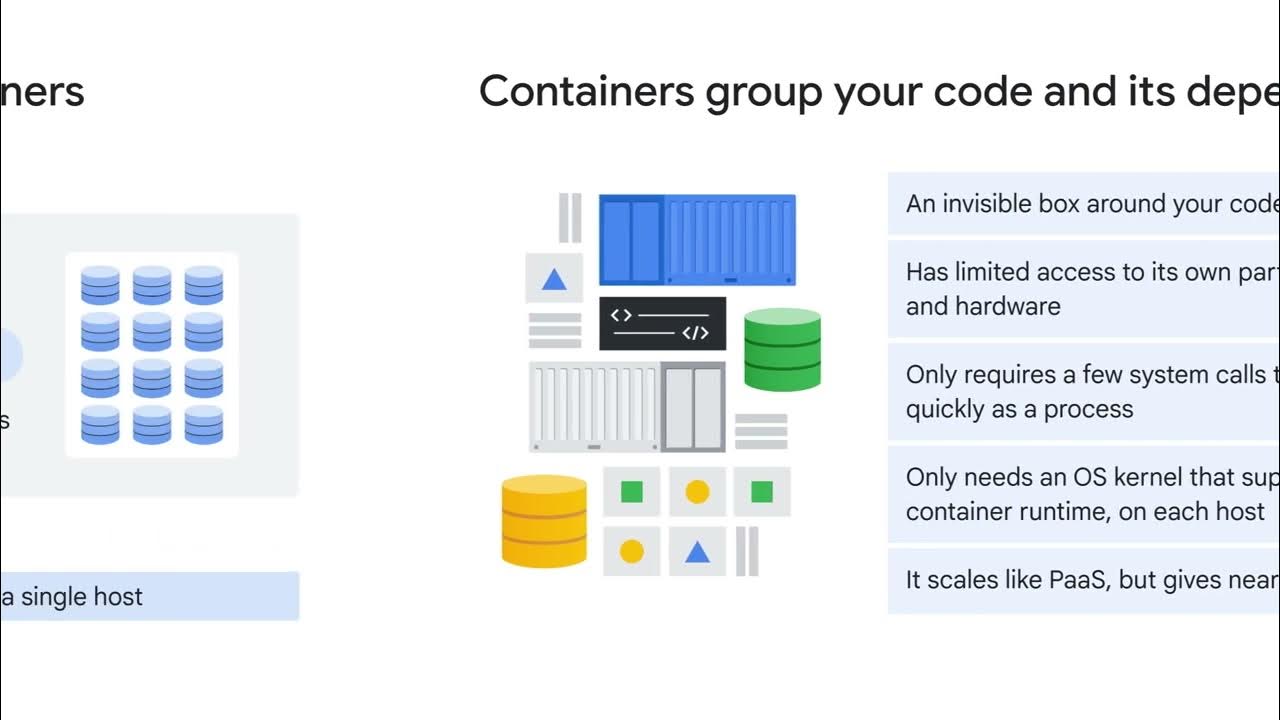What Is Kubernetes - The Engine Behind Google's massive Container Systems | KodeKloud
Summary
TLDRThis video introduces Kubernetes, a powerful container orchestration tool, and explains its relationship with Docker. It covers key concepts such as scaling applications, handling failures, and managing large-scale deployments. The video highlights Kubernetes' ability to automate container management, improve fault tolerance, and provide advanced networking, storage, and security features. With Kubernetes, users can manage thousands of containers, scale applications automatically, and streamline upgrades. The video also provides an overview of Kubernetes' architecture, including nodes, masters, and the kubelet, as well as how to use the kubectl command-line tool to interact with Kubernetes clusters.
Takeaways
- 😀 Docker allows you to run a single instance of an application, but as user demand grows, scaling requires manual intervention with additional containers.
- 😀 Container orchestration solutions help automate scaling, monitoring, and failure recovery of applications, making it more efficient for large-scale deployments.
- 😀 Kubernetes is one of the most popular container orchestration solutions, enabling the management of applications across thousands of instances with ease.
- 😀 Kubernetes supports automatic scaling, both vertically and horizontally, based on user load and infrastructure demands.
- 😀 Kubernetes supports rolling upgrades, allowing you to update applications one instance at a time, ensuring zero downtime during updates.
- 😀 Kubernetes integrates with a wide range of networking, storage, and cloud providers, offering flexibility for production environments.
- 😀 While Docker is typically used as the container runtime, Kubernetes can also work with alternatives like Rocket and Cryo.
- 😀 Kubernetes clusters consist of nodes (worker machines) and a master node that controls orchestration and monitors the cluster's health.
- 😀 The master node in Kubernetes is responsible for managing the entire cluster, while worker nodes run the applications.
- 😀 Kubernetes uses a command-line tool called `kubectl` (or `kubectl`), which allows you to deploy, manage, and interact with applications on a Kubernetes cluster.
Q & A
What is the main purpose of container orchestration?
-Container orchestration is a solution designed to manage and automate the deployment, scaling, and operation of containerized applications, especially in production environments. It ensures that containers are properly distributed across hosts, monitors their health, and handles failures without manual intervention.
What problem does Kubernetes solve compared to running containers manually with Docker?
-Kubernetes solves the problem of manual management by automating container deployment, scaling, and monitoring. It allows you to manage large numbers of containers across multiple hosts, ensuring application availability and resource scaling without the need for constant manual intervention.
How does Kubernetes handle application scaling?
-Kubernetes can automatically scale applications by increasing or decreasing the number of container instances based on user load. It can be configured to scale up or down in response to demand changes, either manually through commands or automatically based on predefined rules.
What is the difference between Docker Swarm and Kubernetes?
-Docker Swarm is easier to set up and use but lacks advanced auto-scaling features needed for complex, production-grade applications. Kubernetes, while more difficult to set up, offers powerful scaling, management, and customization options, and supports a wide range of storage and networking plugins.
What are the key components of a Kubernetes cluster?
-A Kubernetes cluster consists of nodes, with each node being a physical or virtual machine running the Kubernetes software. It also includes the control plane, which manages the cluster, and worker nodes that run containers. Key components include the API server, etcd key-value store, scheduler, controllers, and the kubelet.
What role does the Kubernetes master play in managing a cluster?
-The Kubernetes master manages the overall operation of the cluster, including orchestrating container deployment and monitoring the health of nodes. It runs the control plane, which is responsible for maintaining cluster state and distributing workloads across the worker nodes.
What is the purpose of the etcd key-value store in Kubernetes?
-The etcd key-value store in Kubernetes is used to store all the data required to manage the cluster, such as node information, configuration data, and the current state of the cluster. It ensures data consistency and helps coordinate operations between multiple masters in the cluster.
How does Kubernetes ensure application reliability when a node fails?
-Kubernetes ensures reliability by monitoring the health of nodes and containers. If a node fails, Kubernetes automatically reschedules the affected containers to other healthy nodes, ensuring that the application remains accessible and operational without manual intervention.
What is the purpose of the kubelet in a Kubernetes node?
-The kubelet is an agent that runs on each worker node in the Kubernetes cluster. It ensures that containers are running as expected on the node by interacting with the container runtime and reporting the status of containers back to the control plane.
How can you interact with a Kubernetes cluster?
-You can interact with a Kubernetes cluster using the `kubectl` command-line tool. This tool allows you to deploy applications, view cluster information, check the status of nodes, and manage other aspects of the cluster.
Outlines

This section is available to paid users only. Please upgrade to access this part.
Upgrade NowMindmap

This section is available to paid users only. Please upgrade to access this part.
Upgrade NowKeywords

This section is available to paid users only. Please upgrade to access this part.
Upgrade NowHighlights

This section is available to paid users only. Please upgrade to access this part.
Upgrade NowTranscripts

This section is available to paid users only. Please upgrade to access this part.
Upgrade Now5.0 / 5 (0 votes)





